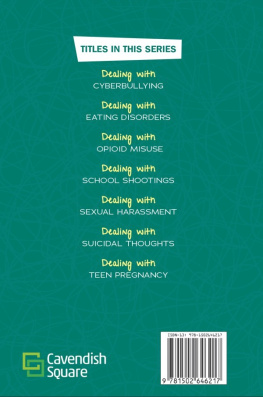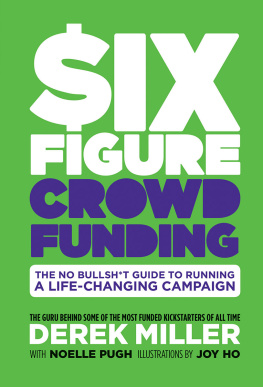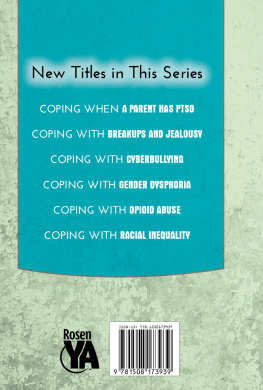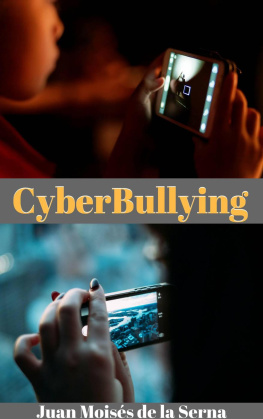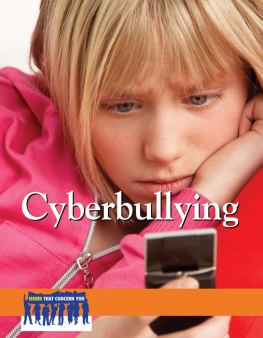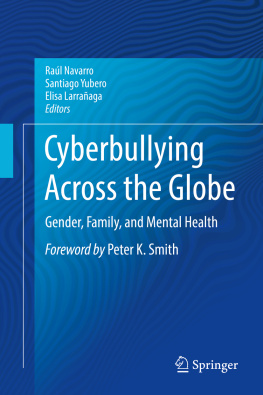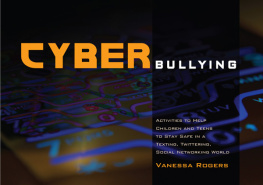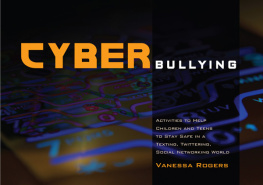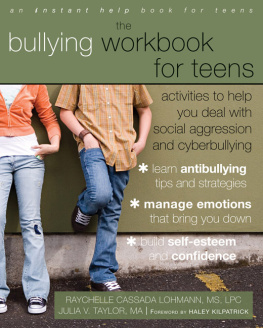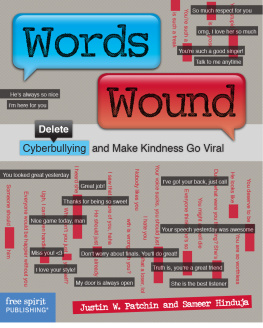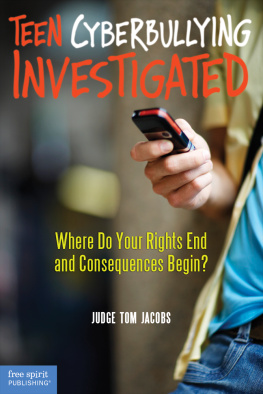
Published in 2020 by Cavendish Square Publishing, LLC
243 5th Avenue, Suite 136, New York, NY 10016
Copyright 2020 by Cavendish Square Publishing, LLC
First Edition
No part of this publication may be reproduced, stored in a retrieval system, or transmitted in any form or by any meanselectronic, mechanical, photocopying, recording, or otherwisewithout the prior permission of the copyright owner. Request for permission should be addressed to Permissions, Cavendish Square Publishing, 243 5th Avenue, Suite 136, New York, NY 10016. Tel (877) 980-4450; fax (877) 980-4454.
Website: cavendishsq.com
This publication represents the opinions and views of the author based on his or her personal experience, knowledge, and research. The information in this book serves as a general guide only. The author and publisher have used their best efforts in preparing this book and disclaim liability rising directly or indirectly from the use and application of this book.
All websites were available and accurate when this book was sent to press.
Cataloging-in-Publication Data
Names: Miller, Derek.
Title: Dealing with cyberbullying / Derek Miller.
Description: New York: Cavendish Square Publishing, 2020. |
Series: Helping yourself, helping others | Includes glossary and index.
Identifiers: ISBN 9781502646200 (pbk.) | ISBN 9781502646217 (library bound) |
ISBN 9781502646224 (ebook)
Subjects: LCSH: Cyberbullying--Juvenile literature.
Classification: LCC HV6773.15.C92 M555 2020 | DDC 302.34/3--dc23
Editorial Director: David McNamara
Editor: Caitlyn Miller
Copy Editor: Rebecca Rohan
Associate Art Director: Alan Sliwinski
Designer: Ginny Kemmerer
Production Coordinator: Karol Szymczuk
Photo Research: J8 Media
The photographs in this book are used by permission and through the courtesy of:
(Note: cover, p .
Printed in the United States of America
Some of the images in this book illustrate individuals who are models. The depictions do not imply actual situations or events.
CONTENTS

Cyberbullying is a form of repeated harassment that takes place over the internet or via text message.
Chapter 1
The Facts About Cyberbullying
T he internet and smartphones have made it easier than ever to insult, threaten, and harass. As a result, cyberbullying has become a serious problem for teens everywhere. One in four American teens have been the victim of cyberbullying. Many more have seen it happen to someone they know or have been involved in cyberbullying. If you have been the victim of cyberbullying, you are not alone. There is help available, and there are solutions to the problem.
WHAT IS CYBERBULLYING?
At the most basic level, cyberbullying is using technology, like the internet and cell phones, to bully or harass someone repeatedly. This harassment and bullying can take many different forms. Mean messages, hurtful comments, threats of violence, sharing embarrassing pictures, and pretending to be someone else are some common forms of cyberbullying.
To be classified as cyberbullying, the person responsible must intend to hurt the victim. If the embarrassment or harm is accidental rather than intentional, it is not cyberbullying. For instance, sharing a picture that is embarrassing for one of the people in it without realizing theyll be embarrassed is not cyberbullying. Intentionally sharing the picture to embarrass someone can be cyberbullying.
The definition of traditional, in-person bullying says that harm must occur more than once. The repeated nature of bullying is what makes it different from harassment. Being pushed or insulted once is harassment. When it happens repeatedly, it is bullying. The same is true for cyberbullying. The nature of cyberbullying, however, means that one act can harm someone repeatedly. Publishing a web page that makes fun of someone and leaving it open for comments can cause harm again and again as people look at it. This qualifies it as cyberbullying. Of course, one-time harassment is still a serious matter that can have consequences for both the perpetrator and the victim.

Smartphones have connected people more than ever before. Unfortunately, they can also be used to cyberbully.
When actions online or on other kinds of technology result in repeated and intentional harm, it is cyberbullying. Most experts agree that it is the intention, repetition, and harm that all add up to cyberbullying. Here are some examples of what this can look like in real life.
Messages and Comments
Sending someone hurtful messages is one of the most frequent ways people are cyberbullied. Often, the messages are mean and tear someone down. They might call the the victim names or belittle them. There are many different platforms where people receive hurtful messages, from social media sites like Facebook and Instagram to text messages and email. Frequently, the bully sends the messages openly, and the victim knows who it is, although occasionally messages are sent anonymously.
Bullying messages may be private or visible to the public. Mean comments on social media are not only hurtful when read by the victim but may also inspire other bullies to post similar abuse. In some cases, these messages may even threaten physical harm. Threats can be traumatizing for the victim and make them fear for their safety at school or even in their home.
Rumors and Gossip
Spreading rumors about someone online or over the phone is another way that cyberbullies can hurt their victims. Rumors and gossip can be spread without the victims knowledge. Friends and classmates might hear hurtful rumors or insults before a victim is aware that theyre being cyberbullied.
Like hurtful messages, rumors can be spread on many different platforms, including group texts and social media. In extreme cases, a cyberbully can even make a website or web page about one or more victims. Rumors, embarrassing photos, and insults might be posted there repeatedly by the cyberbully who made the siteand sometimes by other people as well. According to a 2016 survey by the Cyberbullying Research Center, a shocking 7.4 percent of twelve- to seventeen-year-old students reported that a website created to make fun of them was posted online in the past month.
Photographs and Videos
Cyberbullies sometimes use photographs and videos of a victim to humiliate them. This can be as simple as an unflattering photograph or one where the victim is doing something embarrassing. Posting it online, with or without a hurtful comment, can shame the victim and encourage other people to make fun of them.
A growing problem is the sharing of photos or videos where the victim is partially or fully undressed. These explicit images may have been taken by the victim or with their permission. Either way, when the photos are shared more widely, it is a form of cyberbullying. Spreading explicit images of a person without their consent is a very serious matter and is illegal in many states. It can make the victim feel powerless and betrayed.
Impersonation
Technology affords cyberbullies the opportunity to impersonate, or pretend to be, someone else. Since a cyberbully is hidden behind a screen, it is difficult for the victimor other peopleto tell if someone is being impersonated.

